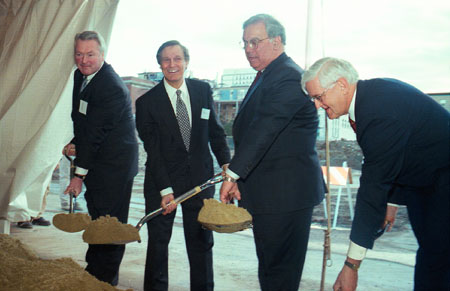HMS breaks ground for research building

Saying, in essence, “You ain’t seen nothin’ yet,” Harvard and Boston officials ceremonially broke ground Feb. 1 for a new Harvard Medical School research building designed to promote collaboration among researchers.
Harvard President Neil L. Rudenstine said the timing of the new building couldn’t be better, predicting that recent advances in medical technology, combined with the massive base of medical knowledge built up over the last 50 years, will soon lead to an explosion of discovery.
“We will certainly see more and more in the next decades, in what will be the most extraordinary period of discovery in the medical sciences,” Rudenstine said.
Boston Mayor Thomas Menino agreed, predicting cures for several of today’s devastating diseases from the research to be conducted in the new building. Menino was among about 150 who attended the groundbreaking ceremony.
“On this very ground, in the very near future, I believe we’ll find a cure for AIDS [or] a cure for cancer,” Menino said.
The 430,000-square-foot structure, simply called New Research Building, will fill an L-shaped lot on Avenue Louis Pasteur, adjacent to the Harvard Institutes of Medicine and across the street from Boston Latin School. It will house about 800 researchers and is expected to open in 2003.
The building, with shared kitchen and lounge spaces, shared core laboratory facilities, and adjacent facilities assigned to researchers doing related work, is designed to encourage collaboration.
The $250 million project will consist of two main parts. The first is a low-rise component reaching four stories and fronting on Avenue Louis Pasteur. The second is a 10-story high-rise tower directly beside the Harvard Institutes of Medicine. The tower portion will be connected to the Harvard Institutes of Medicine on each floor by pedestrian walkways.
The building will house the Medical School’s Departments of Pathology and Genetics, with adjacent floors in the new building and in the Harvard Institutes of Medicine housing similar research functions. Research on Alzheimer’s, diabetes, heart disease, stroke, and cancer will be among a wide range of investigations conducted in the new facility.
Harvard Medical School Dean Joseph Martin hailed the new facility as a “wonderful opportunity.” The new building will anchor a new North Quadrangle, consisting of the structures on the north side of Longwood Avenue: the new research building, the Harvard Institutes of Medicine, and the Medical School’s Vanderbilt Hall dormitory.
The space made available in South Quadrangle buildings with the move of the Pathology and Genetics Departments to the new building will be filled by expansion of the existing departments of Neurobiology, Cell Biology, Microbiology and Molecular Genetics, and Biological Chemistry and Molecular Pharmacology as well as fledgling initiatives including the Center for Neurogeneration and Repair, an expansion of the Institute of Proteomics and the Center for Genomic Applications and Therapeutics.
Martin said the School’s relationship with its teaching hospitals has always been critical. Collaboration between basic scientific research and the clinical research conducted at the teaching hospitals will also be fostered in the new building, where researchers in both areas will work side by side.
“Our mission at Harvard Medical School is to create and to nurture a community of the best people committed to ending human suffering,” Martin said. “To accomplish our mission requires the old walls that separated disciplines … be torn down.”




